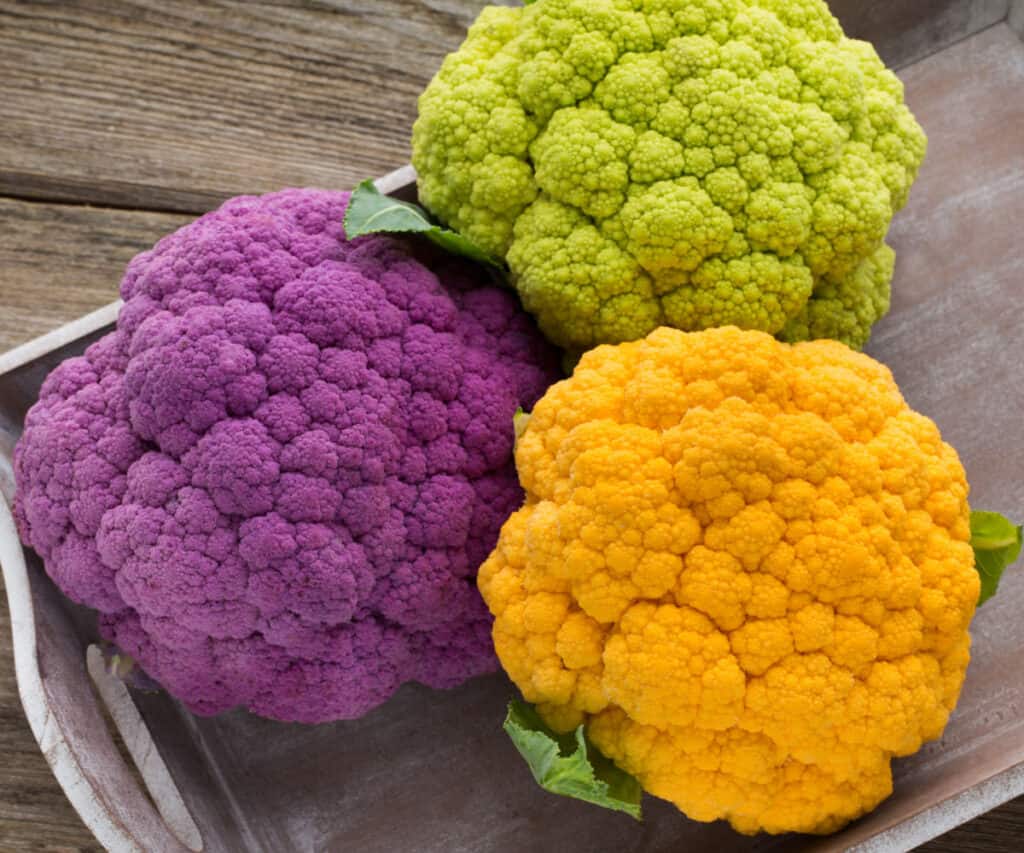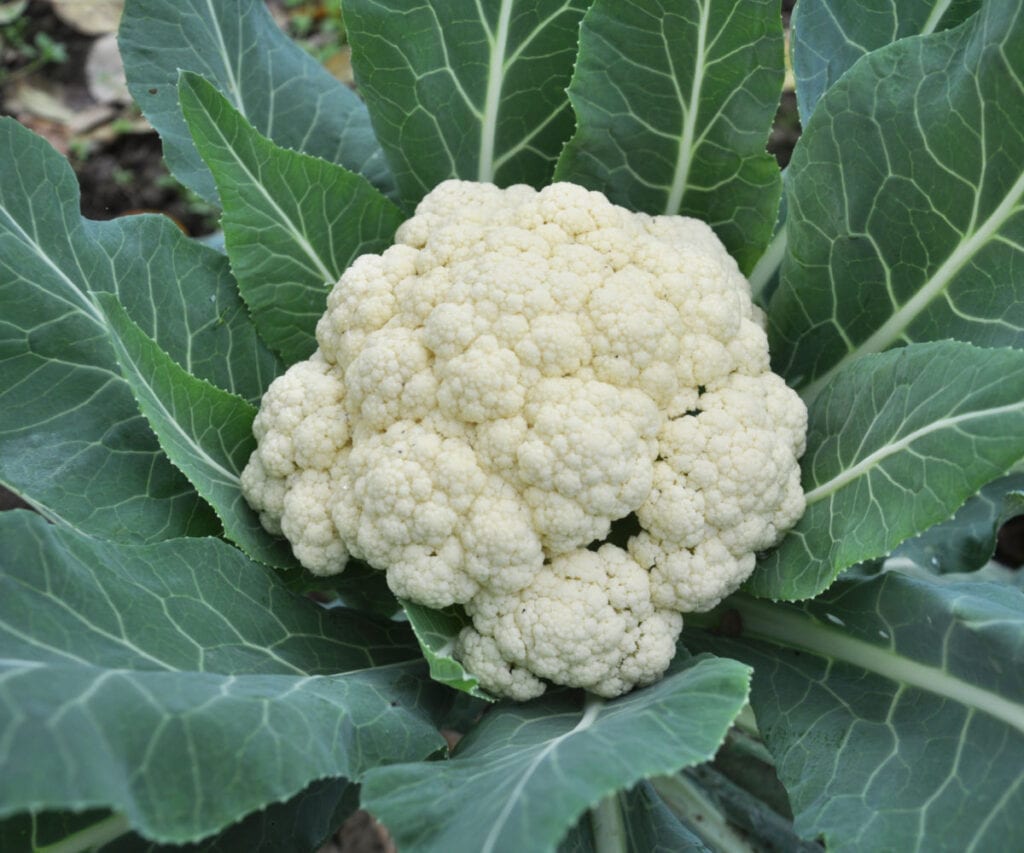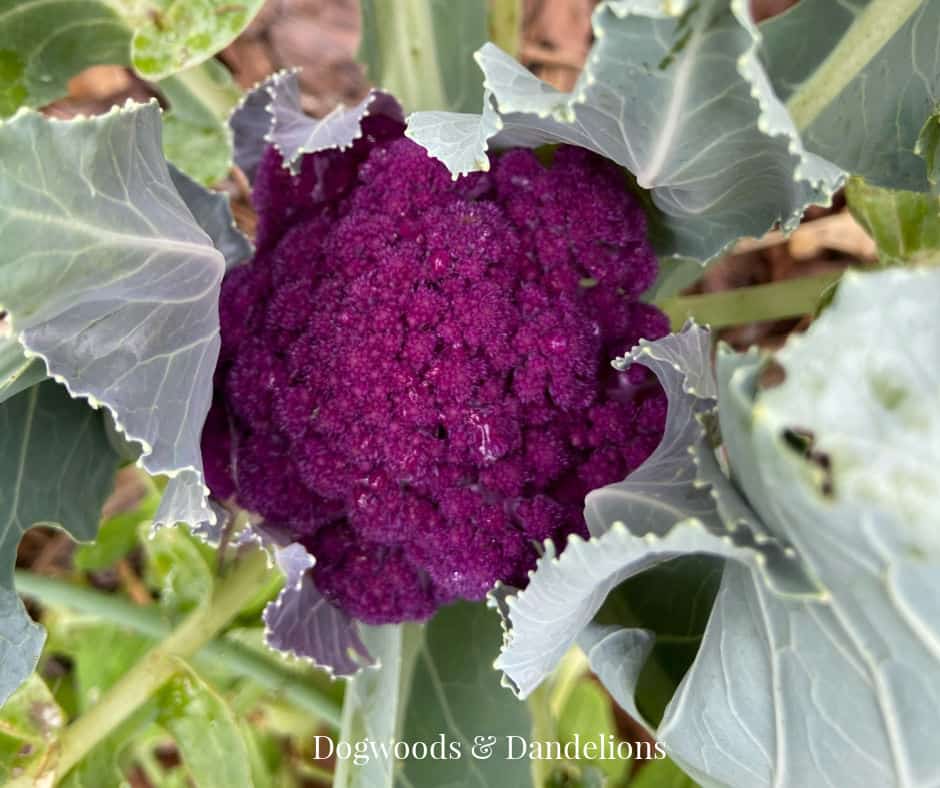How To Grow Cauliflower
Cauliflower is a great vegetable to grow for the backyard gardener. There are many varieties that you can’t find in the store – purple and yellow cauliflower for example.
But cauliflower is a bit more temperamental than most other vegetables in the brassicas family. Learn how to grow cauliflower in your own garden.
Affiliate Disclosure: Please note that some of the links in this article may be affiliate links and I may receive a small commission if you purchase something through a link. It will not change your cost. As an Amazon Associate, I earn from qualifying purchases. For more information, see my disclosures page.)
How to Plant Cauliflower
Cauliflower is best started with purchased transplants or from seed you start indoors. I don’t recommend starting it directly in the ground outdoors.
Cauliflower is a cool-season vegetable preferring temperatures in the 60’s. If starting your own transplants for spring, start indoors 4 – 7 weeks before your last frost. If planting for fall, start indoors 6 – 10 weeks before your first fall frost.
Plant seeds 1/4″ deep in seed starter mix or Jiffy pellets. Provide steady moisture while the seeds are germinating and throughout the growing season. You can transplant cauliflower to the garden 2 to 4 weeks before your last frost in the spring. If planting for a fall crop, plant outdoors 6 – 8 weeks before your first fall frost.

Cauliflower needs at least 6 hours of sunlight a day, but more is preferable. To prevent “buttoning” (see below) plant in fertile soil with a soil pH between 6.5 and 6.8. (Not sure of your soil’s pH? Learn how to do a soil test.)
Space the plants 18″ apart. If planting in a traditional row garden, space the rows 30″ apart.
When transplanting your starts or purchased ones, place a stick against the stem or a toilet paper roll around the plant if cutworms are a problem in your area. I forgot to do this one year and lost every single cauliflower plant in one night.
Fertilize your cauliflower with a quality vegetable fertilizer every 2 to 3 weeks and keep it evenly watered. Good mulch will also help keep the moisture levels consistent.
As I said at the beginning, cauliflower is very temperamental and likes temperatures between 55 and 75 degrees. Be ready to cover the cauliflower with shade cloth should the temperatures rise. If they fall too low, a row cover will help provide a little warmth to even out the temperature swings.

How to Blanch Your Cauliflower
Once the heads are about 2″ across, you will need to blanch your cauliflower to keep the heads white. No, this is not the same thing as boiling the vegetable once harvested before preserving it. You actually blanch cauliflower on the plant by covering the head with the leaves of the plant.
This can be accomplished in several ways. One way is to just break the leaves over to where they cover the cauliflower head. They will still be attached to the plant but will cover the head. If they will stay in place, this is works well. This is the method I have always used.
But recently, I discovered another method that I think will work even better. Bring the leaves of the plant together above the head and clothespin them together. I can’t wait to try this method in my garden.
Many varieties of cauliflower say they are self-blanching. However, it is still good practice to fold over a few leaves to ensure the cauliflower heads remain covered. If you are growing colored cauliflower like yellow, green, or purple, there is no need to blanch the cauliflower.

How to Harvest Cauliflower
Cauliflower needs to be harvested once the heads get between 6 and 8″ across. If the buds show any signs of starting to open and flower, harvest immediately.
Otherwise, it will be too late. To actually harvest the head, take a knife out to the garden and slice the head off the plant.
Once you have harvested the cauliflower head, you can remove and dispose of the plant. Unlike broccoli, cauliflower will not regrow small side shoots. It’s a one-and-done plant.
If the cauliflower buds start to open, harvest the plant immediately, regardless of the size. Sometimes the heads will “button” only growing 2-3″ across before trying to flower.
This is usually caused by too hot or too cold weather or not enough water. It can also happen because of a lack of nutrients in the soil.
If your heads start to button, harvest immediately. The cauliflower is safe to eat but it will never get any bigger.
Once the buds on the heads start to open, the head will never get any bigger. The cauliflower is trying to flower and produce seeds. If you don’t harvest then, the head will be bitter and not worth eating.
Cauliflower can be stored in the refrigerator for up to 2 weeks. It is worth noting that the leaves of the cauliflower plant are also edible.

Cauliflower Pests & Diseases
Pests
There are many pests that like cauliflower too. The most common one is cabbage moths. I have learned over the years to go ahead and cover my cauliflower (and cabbage and broccoli) with a row cover as soon as I plant it to keep the insects out.
If you notice pretty white moths flying around your brassicas, it’s already too late to cover the plants. The cabbage moths lay their eggs in the plants and once they hatch, you will have an infestation of worms. Yuck.
If you do need to spray, bacillus thuringiensis, also known as BT, is the recommended treatment. This is a treatment that the worms need to eat to be effective. It is approved for organic gardening and is generally considered safe as it doesn’t harm bees, ladybugs, and other beneficial insects.
Other pests include aphids, cabbage root maggots, and flea beetles. Many of these pests can be controlled with diatomaceous earth.
I personally feel these are very safe pest control methods. However, when using any pesticide in your garden, please do the research yourself to be sure you are comfortable using it.
Diseases
There are a few diseases that can affect cauliflower. The two most common are clubroot and black rot. Clubroot is a disease that is soil borne. It enters the plants through the roots causing the roots to enlarge. The roots decay along with the cauliflower plant.
Black rot, also called bacterial soft rot, starts off looking like water-logged areas on your plants. The area expands and becomes soft and mushy. This disease often enters the plants through damaged areas from insects and wet or humid conditions accelerate the disease.

Recommended Varieties of Cauliflower
- Snowball is a self-blanching white variety whose leaves wrap around the heads to protect them from the sun.
- Amazing is also a self-blanching type that tolerates both heat and cold a bit better than other varieties. This would be my first choice for a beginning gardener that wants to grow cauliflower.
- Cheddar is a beautiful yellow cauliflower that is the color of cheddar cheese. The color only deepens when cooked. It is best grown in the fall.
- Graffiti has gorgeous purple heads that stay purple when cooked. It is also best grown as a fall crop.
- Romanesco is a greenish-yellow cauliflower that forms heads with spires. It has a nuttier taste than other types. The most common variety is Veronica.
So while cauliflower isn’t necessarily the easiest vegetable to grow, I do recommend you give it a try after you’ve gardened for a few years. It is absolutely delicious and you can grow varieties you just can’t find anywhere else.
Related Posts
- How to Grow Broccoli
- Planting a Fall Garden
- Cool-Season vs. Warm-Season Vegetables – Do you know the difference?
